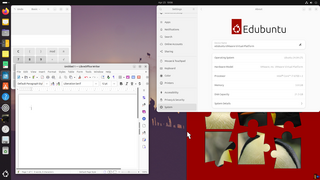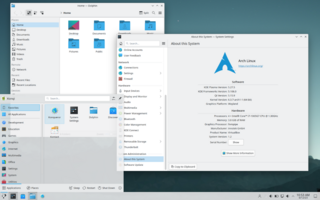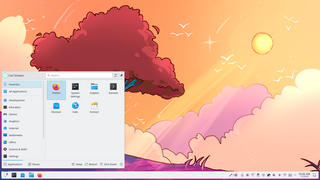 Base logo (many thematic variations also in use) [1] | |
 KDE neon 6.0 | |
| Developer | KDE |
|---|---|
| Written in | C/C++/Qt 6 |
| OS family | Linux (Unix-like) |
| Working state | Current |
| Source model | Open source |
| Initial release | June 8, 2016 [2] |
| Latest release | User Edition: 20240228, based on Ubuntu 22.04 and Plasma 6, kernel Linux 6.5 / 28 February 2024 |
| Repository | community |
| Marketing target | People who want the newest versions of KDE Plasma |
| Available in | 80 languages [3] |
List of languages Afrikaans, Albanian, Amharic, Aragonese, Arabic, Assamese, Asturian, Basque, Belarusian, Bengali, Bokmål, Bosnian, Breton, Bulgarian, Burmese, Catalan, Chinese, Crimean, Croatian, Czech, Danish, Dutch, Dzongkha, English, Esperanto, Estonian, Finnish, French, Friulian, Gaelic, Galician, German, Greek, Gujarati, Hebrew, Hindi, Hungarian, Icelandic, Indonesian, Interlingua, Irish, Italian, Japanese, Kannada, Kazakh, Khmer, Korean, Kurdish, Latvian, Lithuanian, Macedonian, Malay, Malayalam, Mandarin, Marathi, Nepali, Norwegian, Occitan, Oriya, Persian, Polish, Portuguese, Punjabi, Romanian, Russian, Serbian, Sinhala, Slovak, Slovenian, Spanish, Swedish, Tajik, Tamil, Telugu, Thai, Turkish, Ukrainian, Uyghur, Vietnamese, Welsh | |
| Update method | APT |
| Package manager | PackageKit [4] /Discover (GUI) |
| Platforms | x86-64 [5] /AArch64 [6] |
| Kernel type | Monolithic |
| Userland | GNU, Ubuntu long-term support base |
| Default user interface | KDE Plasma 6 |
| License | Various open-source licenses, mainly the LGPL-2.1 and GPL-2 |
| Official website | neon |
KDE neon is a Linux distribution developed by KDE based on Ubuntu long-term support (LTS) releases, bundled with a set of additional software repositories containing the latest versions of the Plasma 6 desktop environment/framework, Qt 6 toolkit and other compatible KDE software. [7] [8] [9] [10] [11] [12] [13] First announced in June 2016 by Kubuntu founder Jonathan Riddell following his departure from Canonical Ltd., [14] it has been adopted by a steadily growing number of Linux users, regularly appearing in the Top 20 on DistroWatch.com's popularity tables. [15]
Contents
It is offered in stable and development variants; the User Edition is a stable release featuring the latest KDE packages that have passed their quality assurance, while the Testing,Unstable, and Developer Edition branches use the latest beta and unstable nightly releases of KDE packages (the last of which bundled with KDE development libraries and headers). [16]
















